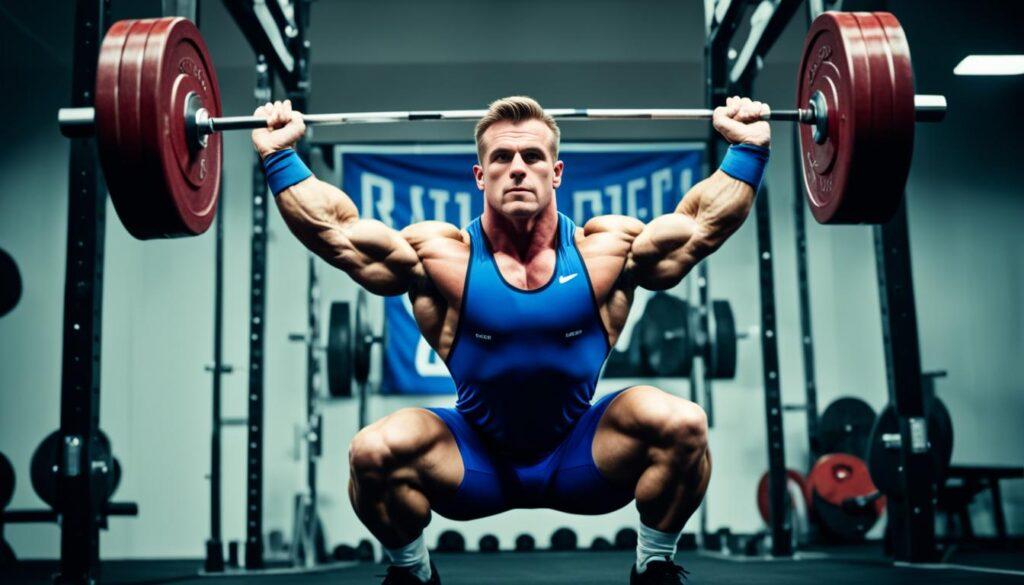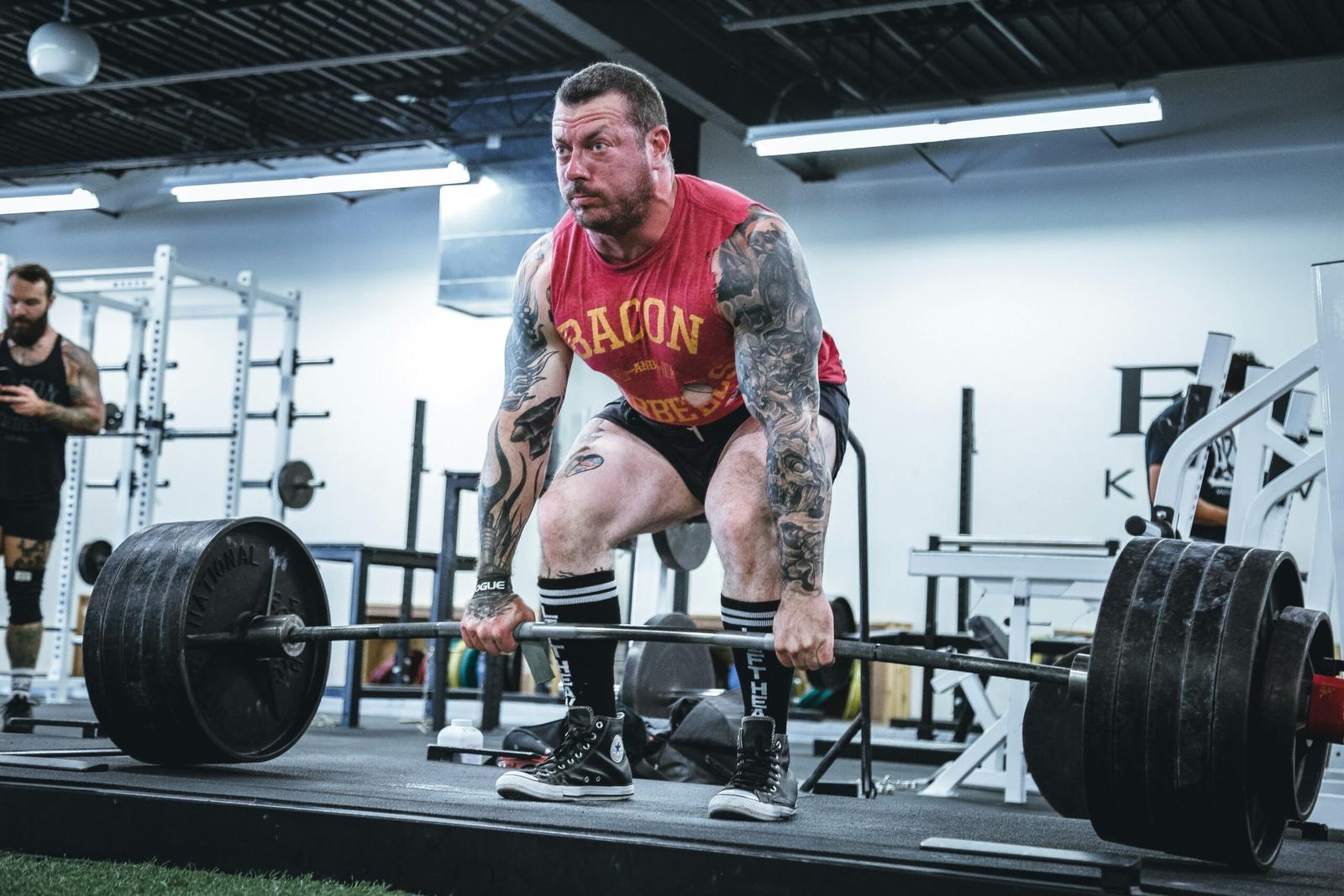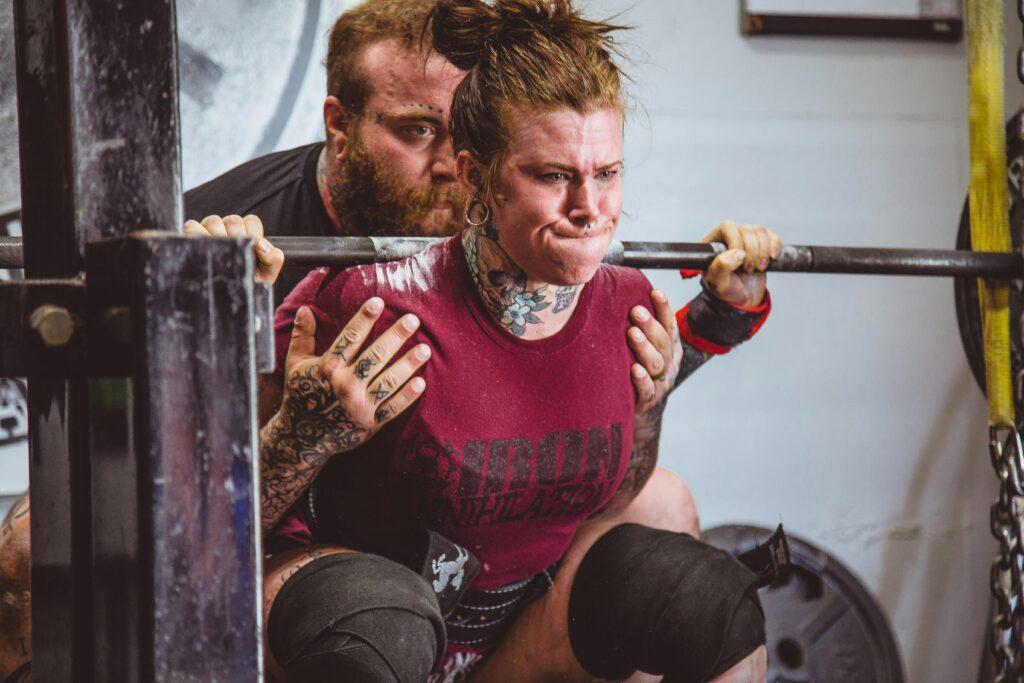Embark on your journey to powerlifting success with a resolve to transform not just your muscles but your mindset. The secret to powerlifting is not a secret after all—it’s a commitment to comprehensive strength training, refining your technique, and forging a bond with the ever-supportive powerlifting community.
Your arduous effort, guided by seasoned coaches and supported by the right equipment and supplements, sets the foundation for unparalleled accomplishments. Remember, beyond the iron and chalk lies a world powered by effective recovery and a resilient mindset.
Key Takeaways
- Powerlifting requires dedication to both strength and technique for continuous improvement.
- Guidance from experienced coaches is invaluable in your powerlifting journey.
- Choosing the right equipment and supplements can significantly enhance your performance.
- Do not underestimate the importance of recovery as part of your training regimen.
- A positive mindset is a crucial element for achieving your goals in powerlifting.
- Being an active participant in the powerlifting community can offer motivation and support.
Mastering the Big 3 Lifts: Squat, Bench Press, and Deadlift
Embarking on the journey of powerlifting, you know that the heart and soul of strength training lay in perfecting the big 3 lifts: the squat, bench press, and deadlift. Renowned powerlifter James Simmons stands as a testament to the incredible potential these lifts have for strength development and achieving technique mastery. But how exactly do you deepen your squat depth, increase your bench press power, and refine your deadlift technique? Let’s break down each lift and the nuances that can transform your performance.
Firstly, let’s talk squats. Achieving the proper squat depth is essential—not only does it engage more muscle groups, but it also helps you maximize your lift’s efficiency. Below are some tips to enhance your squat:
- Maintain a tight core and a neutral spine throughout the lift.
- Position your feet at shoulder width, with toes slightly pointed out.
- Focus on driving through your heels as you push back up.
The bench press is not just about brute force. It’s a skillful balance of power and precision. To boost your bench press power, consider these strategies:
- Prioritize a controlled descent and explosive ascent.
- Make sure your grip is neither too wide nor too narrow.
- Work on activating your lats to support the movement.
And when it comes to the deadlift, your approach can make or break your lifting efficiency. Perfecting your deadlift technique requires a combination of power and finesse:
- Align your shoulders slightly over the bar and keep the bar close to your body.
- Engage your core and ensure your lumbar spine is neutral.
- Drive up with your legs first before extending your hips.
Remember, the path to prowess in these big 3 lifts doesn’t end here. Consistently working on your form, and seeking feedback will be key for your continual strength development. Stay patient and dedicated, as technique mastery is an evolving process, but once attained, it can significantly elevate your powerlifting capabilities. Now, go forth and lift with confidence, precision, and power!
Utilizing Progressive Overload for Continuous Gains
Embarking on the journey of muscular development and strength enhancement hinges on an undeniable truth; without progressive overload, your gains will be gone before you realize it. This crucial training adaptation ensures that you’re not just working hard, but you’re also working smart—cultivating continuous gains for both your training disposition and your overall well-being.
But what does progressive overload look like in practice, and more importantly, how can you make it a staple in your workout regimen? It’s about embracing incremental challenges—and the legends of powerlifting progression are proof that these minute changes breed monumental results. Let’s delve into how progressive overload has scripted success stories and shattered lifting records.
Building Gradually: The Foundation of Progressive Overload
Imagine building a skyscraper. You lay one floor at a time, each new level relies on the sturdiness and support of the one beneath it. That’s how progressive overload works. You add weights incrementally to your barbell, methodically converting those additional kilograms into personal bests. The secret isn’t in the weights themselves but in the way your body adapts, evolves, and toughens up in response to these micro increments—a process that requires patience, perseverance, and a lot of sweat equity.
Application in Training Regimes: Real-World Success Stories
Take a look at any powerlifting progression chart, and you’ll see upward trends that resemble staircases to the stars. It’s no fairytale; it’s the fruit of progressive overload at play. It’s the story of a powerlifter’s journey to continuously surpass personal bests, crafting a workout regimen that speaks to their undying commitment to the craft.
- Analyze your current strength level and establish your baseline for each major lift.
- Set realistic and incremental goals for your lifting records.
- Chart your progress meticulously—each session is a stepping stone to your success.
And here’s where you see the evidence of triumph — where continuous gains are not a mere aspiration, but a reality:
| Training Phase | Focus | Rep Range | Progress Indicators |
|---|---|---|---|
| Foundation Building | Endurance and Stability | 12-15 | Increased stamina, better form |
| Strength Building | Maximal Force Production | 6-8 | Heavier lifts, muscle hypertrophy |
| Power Peaking | Explosive Strength | 1-3 | Personal Records, Lifting Records |
As you march on, these benchmarks reveal more than just what you’ve lifted or how many times you’ve lifted it. They narrate a tale of personal achievement—a saga where each chapter marks a fresh victory, an elevation in your powerlifting progression. They’re footprints that track your journey from the burgeoning newbie to the epitome of strength and muscular development.
So invest in your continuous gains through progressive overload and join the ranks of those success stories that are retold every time a barbell is raised. The path isn’t easy, but as you’ll find, every personal best reset is a triumph that echoes through the halls of powerlifting folklore.
Periodization and Planning: Secrets to Long-term Powerlifting Progression
Embarking on a powerlifting journey means embracing the art and science of training planning. In your quest for achieving remarkable feats of strength, understanding the concept of periodization is akin to uncovering the hidden map to long-term progression. Picture periodization as your highly meticulous training partner, whispering the secrets of when to push hard and when to recover, thus preparing you effectively for upcoming powerlifting meets.
A successful periodization plan breaks down into distinct cycles, each with a purpose, guiding you methodically toward your peak performance. It’s about timing your progressive overload just right, so when the competition comes knocking, you’re not just ready—you’re at your absolute best.
 Macrocycle: The broad view of your training year, where the goal is to structure peak performance around major competitions.
Macrocycle: The broad view of your training year, where the goal is to structure peak performance around major competitions.- Mesocycle: Usually a few weeks to several months where you focus on specific training phases such as hypertrophy, strength, or tapering.
- Microcycle: Typically a week, this cycle gets into the nitty-gritty of your routine, zeroing in on daily and weekly workout variations.
Progressive overload isn’t just about adding more weight to the bar—it’s a strategic tool that, when wielded with expert precision, brings sustainable gains and staves off the dreaded plateaus. We’re talking systematic incremental increases in volume, intensity, and frequency.
Here’s a snapshot of how to synchronize progressive overload with periodization:
| Phase | Objective | Volume | Intensity |
|---|---|---|---|
| Hypertrophy | Build Muscle Size | High | Low to Moderate |
| Strength | Maximize Force Production | Moderate | High |
| Power | Optimize Speed & Strength | Moderate to Low | High |
| Peaking | Prepare for Competition | Low | Very High |
Think of each cycle as a piece of an elaborate puzzle that, when completed, reveals your full potential. As you progress, every rep, every set, and every drop of sweat contributes to an evolving masterpiece of athletic prowess. Stick to the blueprint of periodization and the gains will be not just short-term trophies, but jewels in the crown of your long-term powerlifting progression.
Optimizing Technique for Maximum Efficiency and Safety
As you delve into the realm of powerlifting, it is critical to grasp the concept that technical mastery is not just an option, but a necessity for both safety and efficiency. The journey to squat depth and power output begins with understanding the kinematics behind these movements. This knowledge directly correlates to the muscle recruitment and overall power output that are so essential to your success in lifting.

The Technical Mastery Behind Squat Depth and Power Output
Delving into the squat, a staple in powerlifting, achieving the optimal depth is a balancing act between flexibility, form, and safety in lifting. It’s not only about descending low but doing so with a technique that ensures your joints and muscles are moving synergistically. This allows for optimal muscle recruitment, increasing your efficiency and enhancing power output. Cultivating this skill sets a solid foundation for superior strength gains.
Deadlift Leverages: Understanding the Mechanics for Superior Strength
The deadlift demands an intimate knowledge of your own body mechanics to execute with precision. It is a total-body effort that, when performed with refined deadlift technique, amplifies your strength manifold. By dissecting each phase of the lift, from the initial pull to the lockout, you ensure safety and harness the superior strength needed for remarkable performance. This comprehensive approach to lifting is the backbone to transforming your power output and solidifying your stance in the powerlifting domain.
The Secret to Powerlifting: Balancing Training Intensity and Recovery
Embarking on a powerlifting journey requires meticulous attention to both training intensity and recovery in powerlifting. It’s about more than just lifting heavy weights; it’s about understanding how to prevent injury, balance workout loads, and incorporate adequate rest into your regimen.
Sleep and nutrition play pivotal roles in your recovery process, directly impacting your ability to perform and recover. Prioritizing these aspects ensures that you come back stronger for each training session, thereby maintaining a crucial training balance. Let’s dive deep into how you can optimize each element to support your powerlifting aspirations.
- Optimize Your Workout Intensity
- Listen to your body – know when to push hard and when to pull back.
- Implement deload weeks to allow your muscles and nervous system to recover.
- Invest in quality coaching to ensure effective and safe training practices.
- Enhance Recovery with Sleep and Nutrition
- Aim for 7-9 hours of quality sleep per night to facilitate muscle repair.
- Consume a balanced diet rich in protein, carbohydrates, and healthy fats to fuel your body.
- Stay hydrated and consider using reputable supplements like RuckPack for added recovery support.
- Balance is Key
- Alternate between high-intensity and low-intensity training days.
- Incorporate other forms of lower-impact exercise on rest days to stay active without overtraining.
- Ensure active recovery methods, such as stretching and foam rolling, become part of your routine.
Remember, the goal is not to train until you drop, but to train smartly so that you can lift another day. Recovery should be proactive, not merely a response to overtraining. Embrace the importance of rest and recuperation, and watch your powerlifting performance soar.
Conclusion: The Beyond in Powerlifting – Community, Coaching and Continual Learning
The journey in powerlifting extends well beyond the solitary echo of weights dropping on the platform—it’s the heartbeat of a passionate powerlifting community. Within this network, you’re not just lifting weights; you’re elevating each other through shared sweat, triumphs, and challenges. It’s a space where continual learning reigns supreme, facilitated by seasoned coaching that helps distill years of experience into actionable wisdom. You come to realize, the weight on the bar is just the beginning. The true test is how you harness collective knowledge and harness the support around you to become a formidable athlete.
For women in powerlifting, this community offers a unique platform to shatter glass ceilings with every lift. Amidst the chalk, cheers, and steel, gender barriers dissolve, paving the way for empowerment and recognition. Witnessing the incredible prowess of female powerlifters serves as a beacon, reminding us all of the sport’s inclusivity and its capacity to inspire cross-gender respect and admiration. To echo the sentiments of athletes like James Simmons, it’s about personal bests, progress, and the pure joy of surpassing what you believed were your limits.
In powerlifting, the embodiment of competitive sportsmanship does not overshadow the collective spirit—it amplifies it. The camaraderie found in competitions, the exchange of salutes between rivals, and the synchrony of a crowd gasping and cheering in unison, are the hallmarks of a vibrant athletic tapestry. Stepping onto this path means embracing a lifetime of growth, on and off the platform. So, chalk up, learn constantly, seek wisdom from coaches, and join hands with your peers. Your greatest lift is yet to come, and the powerlifting cosmos is cheering for you.


 Macrocycle: The broad view of your training year, where the goal is to structure peak performance around major competitions.
Macrocycle: The broad view of your training year, where the goal is to structure peak performance around major competitions.





